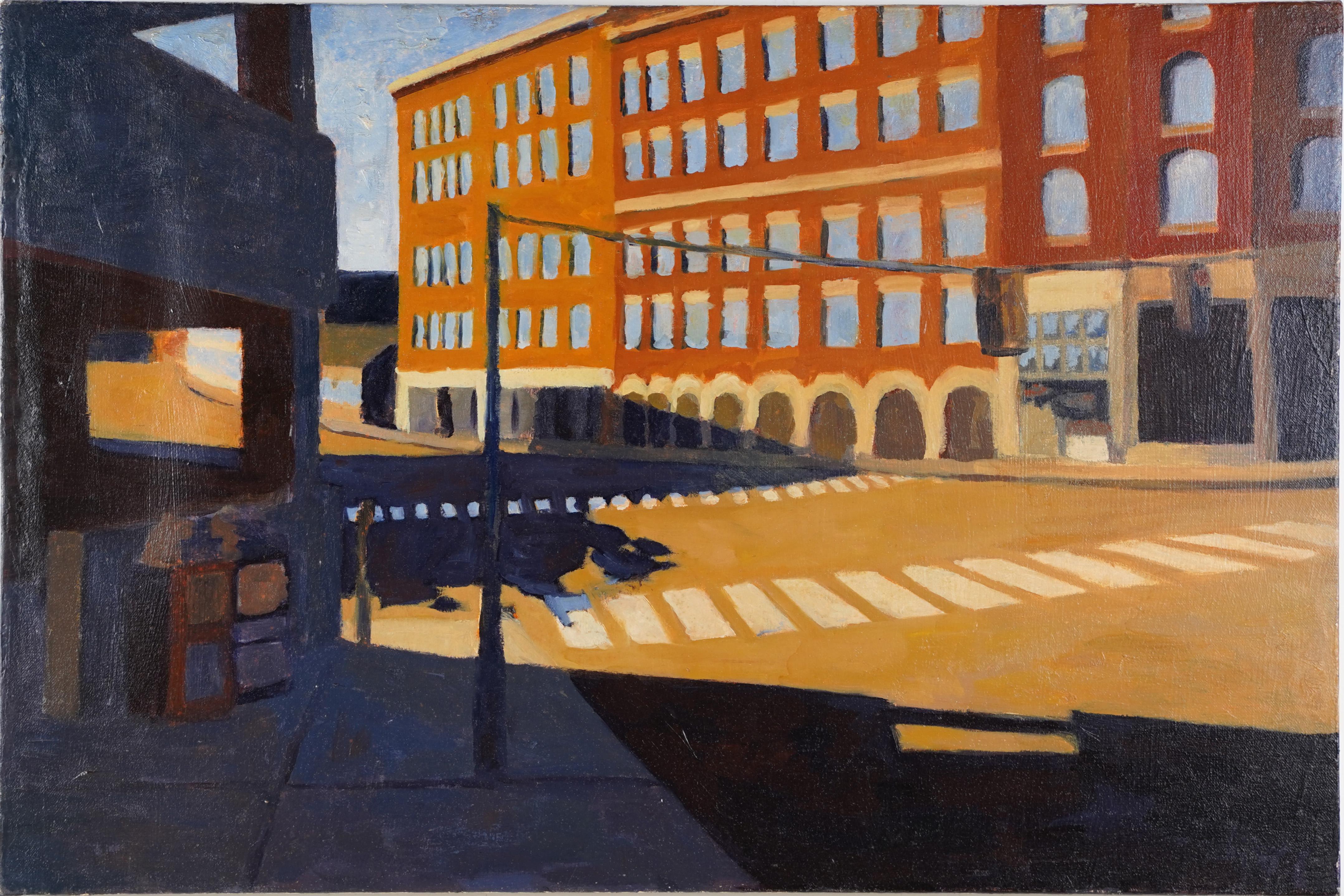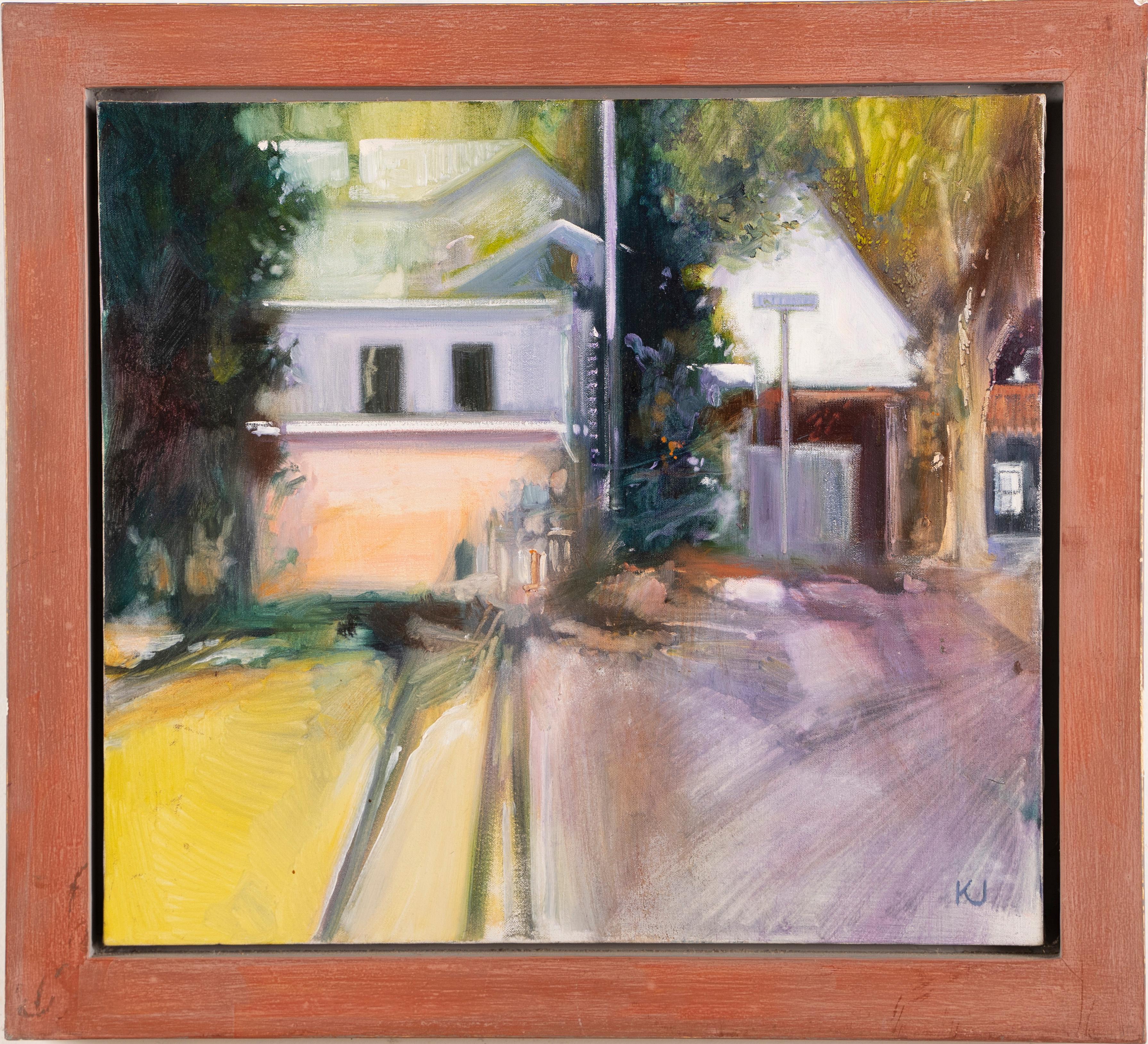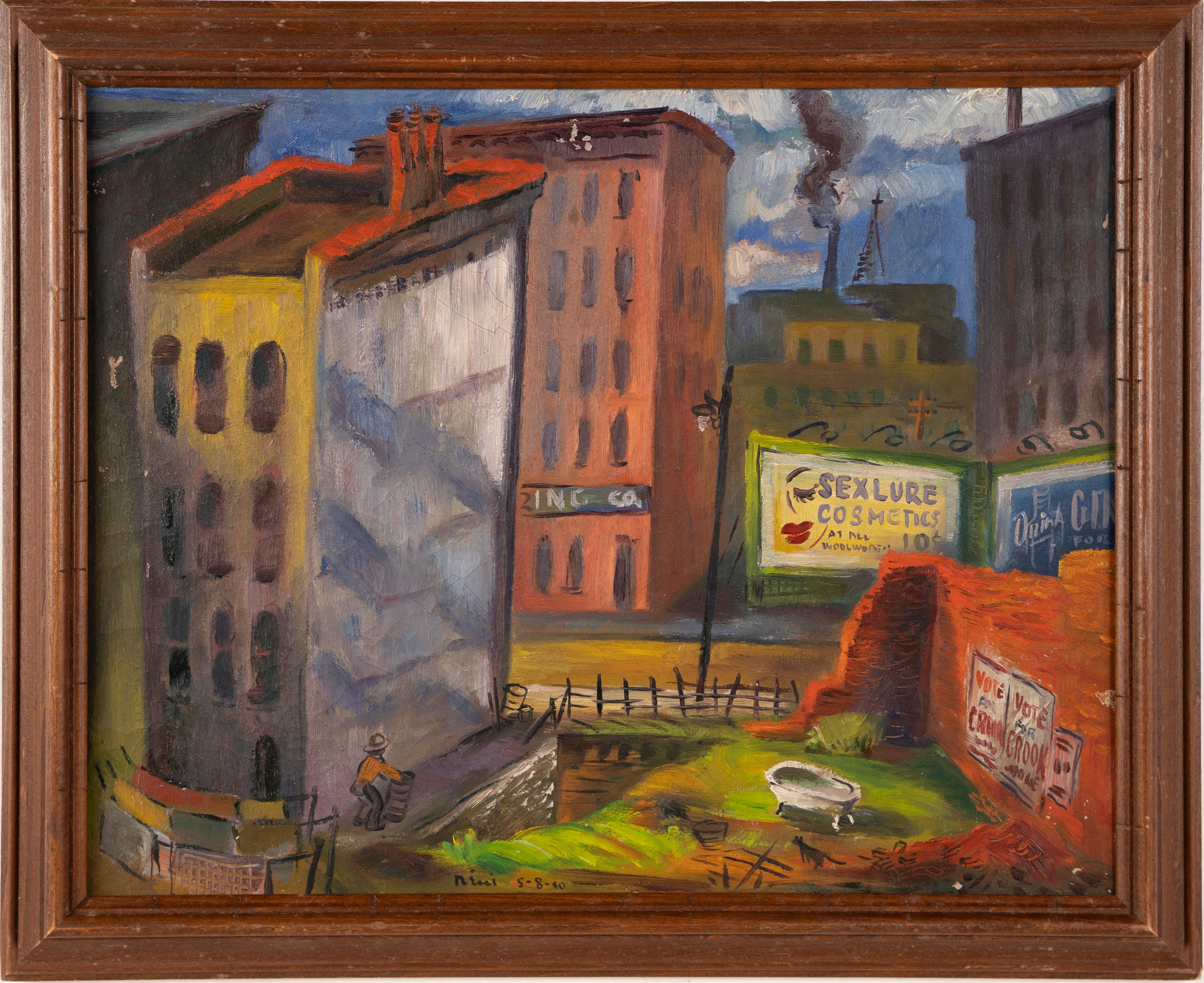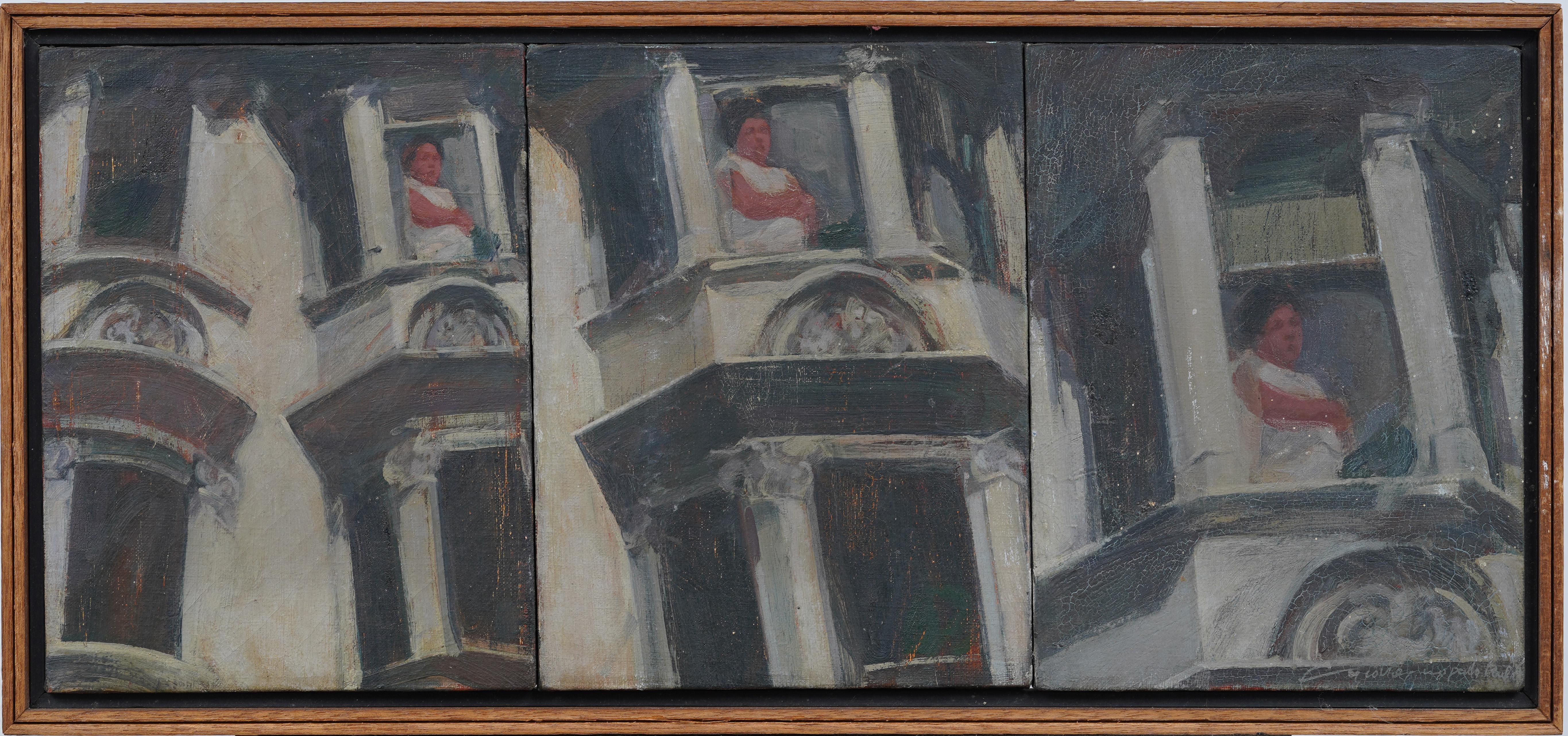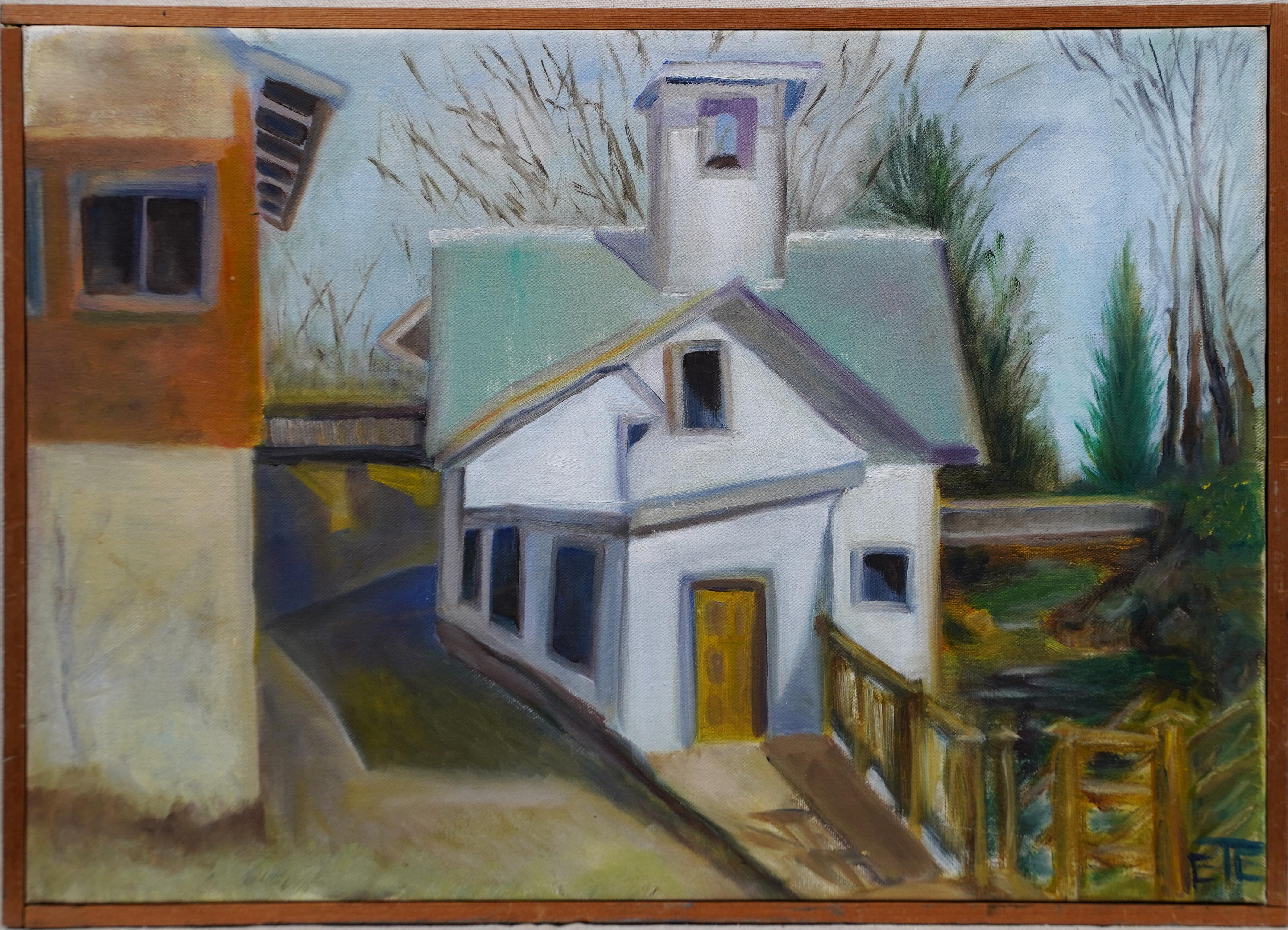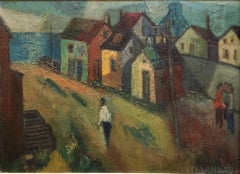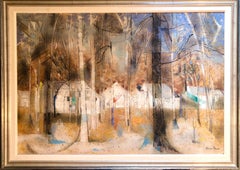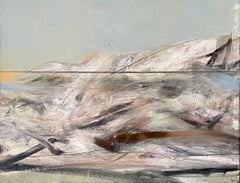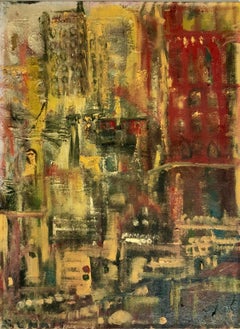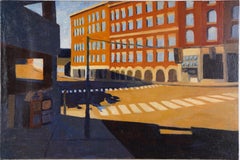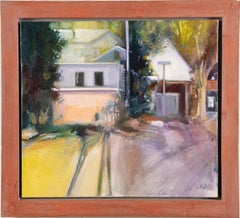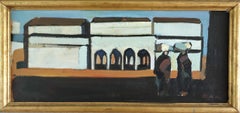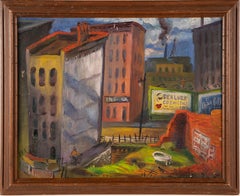Items Similar to Social Realist Street Scene Modernist Landscape Oil Painting
Want more images or videos?
Request additional images or videos from the seller
1 of 7
Paul ZimmermanSocial Realist Street Scene Modernist Landscape Oil Painting1953
1953
$1,800
£1,376.20
€1,585.10
CA$2,522.35
A$2,815.97
CHF 1,475.53
MX$34,470.22
NOK 18,739.19
SEK 17,668.67
DKK 11,829.76
Shipping
Retrieving quote...The 1stDibs Promise:
Authenticity Guarantee,
Money-Back Guarantee,
24-Hour Cancellation
About the Item
Oil Painting Mid 20th century, signed P. Zimmerman Reminiscent of the Mid Century Social Realist and WPA works of Ben Shahn this captures an architectural street scape.
Paul Zimmerman, N.A. (1921-2007). Paul W. Zimmerman was an internationally known artist and professor emeritus of the Hartford Art School. Born April 29, 1921, in Toledo, Ohio, the son of Robert Frazee and Ethel Pearl (Cramer) Zimmerman, Zimmerman passed away December 15, 2007 in Hartford, Connecticut.
Always a great admirer of Cezanne, Zimmerman was particularly drawn to the French painter's innovations regarding space and the fracturing of the traditional picture plane.
In 1947, Henrik M. Mayer, Director of the Hartford Art School at the time, invited Zimmerman to join the faculty. What began as a two-year agreement became a 40-year career. He remained true to his personal artistic vision throughout his long distinguished career and continued to work in his studio, remain engaged in the artistic community and teach part-time at the West Hartford Art League, West Hartford, CT throughout his retirement.
A prolific landscape painter, Zimmerman's oils and watercolors are found in numerous museum, corporate and private collections, including the Connecticut Academy of Fine Arts; the Springfield Museum of Fine Arts; the Pennsylvania Academy of Fine Arts; the Wadsworth Atheneum; The Slater Museum; the University of Notre Dame; Lehigh University; First New Haven National Bank and United Technologies Corporation. He was also commissioned to design a series of murals for Chase Manhattan Bank in New York. Zimmerman is listed in Davenport's, A Grand Tradition: Art and Artists of the Hoosier Salon, and Who was Who in American Art. Born in Toledo Ohio in 1921, he studied at the John Herron Art School and earned his BFA degree in 1946. His work has been represented by galleries in New York, Maine, Connecticut, Ohio, etc. He was an associate member of the National Academy of Design in 1959 and became a full member of the National Academy of Design in 1972. Zimmerman was also a member of the Connecticut Academy of Fine Arts and the Connecticut Water Color Society. His work was exhibited at the famed Hoosier Salon Indiana in 1944, 1948, 1950, 1952, 1955. Also his work was exhibited at the Corcoran Gallery, John Herron Art Musuem Indianapolis, University of Illinois, Pennsylvania Academy of Fine Arts annuals, Connecticut Water Color Society, the National Academy of Design, and the New Britain Museum of American Art. He won many awards such as: The Hallgarten Prize (1954); The Wallace Truman Prize (1956); The Salmagundi Club Prize from the National Academy (1962); Second Prize Butler Art Institute (1958); Members Prize, Boston Arts Festival (1964); The Patrick B. McGinnis Award, Berkshire Arts Festival (1961); Second Prize at Chautauqua (1955); The Howard Penrose Award, Connecticut Academy (1959); Third Prize, Kearney Memorial Regional Exhibition Milwaukee WI (1964); The Gertrude Melcher Springer Prize at the Indiana Exhibition (1959); First Prize, Connecticut Watercolor Society, the J. I. Holcomb Prize from the Herron Art Musuem (1955), and many others. Throughout his extensive career, Paul received well over 86 awards in both regional and national exhibitions. He was also elected a member of the National Academy of Design. His work can be seen in numerous museums, including the Slater Memorial Museum, Springfield Museum of Fine Arts, Pennsylvania Academy of Fine Arts, Wadsworth Atheneum Museum of Art, University of Notre Dame, Lehigh University and Houston Museum of Fine Art, as well as in many corporate and private collections.
- Creator:Paul Zimmerman (American)
- Creation Year:1953
- Dimensions:Height: 16 in (40.64 cm)Width: 36 in (91.44 cm)
- Medium:
- Movement & Style:
- Period:
- Condition:unframed.
- Gallery Location:Surfside, FL
- Reference Number:1stDibs: LU38212530542
About the Seller
4.9
Platinum Seller
Premium sellers with a 4.7+ rating and 24-hour response times
Established in 1995
1stDibs seller since 2014
1,784 sales on 1stDibs
Typical response time: <1 hour
- ShippingRetrieving quote...Shipping from: Surfside, FL
- Return Policy
Authenticity Guarantee
In the unlikely event there’s an issue with an item’s authenticity, contact us within 1 year for a full refund. DetailsMoney-Back Guarantee
If your item is not as described, is damaged in transit, or does not arrive, contact us within 7 days for a full refund. Details24-Hour Cancellation
You have a 24-hour grace period in which to reconsider your purchase, with no questions asked.Vetted Professional Sellers
Our world-class sellers must adhere to strict standards for service and quality, maintaining the integrity of our listings.Price-Match Guarantee
If you find that a seller listed the same item for a lower price elsewhere, we’ll match it.Trusted Global Delivery
Our best-in-class carrier network provides specialized shipping options worldwide, including custom delivery.More From This Seller
View AllWPA Period "Coastal Village" American Modernist Realism Oil Painting Lev Landau
By Samuel David Lev-Landau
Located in Surfside, FL
Signed and titled with Yiddish inscription verso.
9 X 12 inches board size. beng sold unframed.
Painter, New York, N.Y. Samuel David Lev-Landau was born in Warsaw, Poland and emigr...
Category
Mid-20th Century Modern Landscape Paintings
Materials
Oil
American Woman Artist Modernist Large Oil Painting Cubist Influenced Landscape
By Lena Gurr
Located in Surfside, FL
A beautiful wooded landscape scene with houses and trees.
Painted on a masonite board. hand signed lower right. with framers label verso.
Framed to 40 X 55 inches. 33 X 48 without the frame and mat.
It is not dated.
Lena Gurr (1897–1992), was an American woman artist who made paintings, prints, and drawings During the course of her career Gurr's compositions retained emotional content as they evolved from a naturalistic to a semi-abstract cubist style. Born into a Russian-Jewish Yiddish speaking immigrant family, she was the wife of Joseph Biel, also Russian-Jewish and an artist of similar genre and sensibility. Gurr used Lena Gurr as her professional name. After marrying Joseph Biel she was sometimes referred to as Lena Gurr Biel. Biel had been born in Grodno, Poland (later absorbed into Russia) and had lived in England, France, and Australia before coming to New York. An artist, he specialized in landscape paintings and silkscreen printing as well as photography. He studied art at the Russian Academy in Paris. After immigrating to the United States, he studied under George Grosz at the Arts Students League.
Gurr was born in Brooklyn and, apart from brief stays in Manhattan and in Paris, lived there her whole life. This painting bears the influence of Lyonel Feininger an influential German American artist. Gurr began studying art at a young age. In 1919 she studied painting and printmaking at the Educational Alliance Art School and between 1920 and 1922 she won a scholarship to attend the Art Students League where she took classes with John Sloan and Maurice Sterne.
In 1926 and 1928 Gurr participated in group shows at the Whitney Studio Club in Greenwich Village and in 1928 she also participated in the 12th annual exhibition of the Society of Independent Artists at the Waldorf Roof in New York. (Reviewing this show, Helen Appleton Read, the critic for the Brooklyn Daily Eagle, said "I made three discoveries on my first visit, Thomas Nagel, Eugenie McEvoy and Lena Gurr with two figure compositions which have something of Marie Laurencin or Helene Perdriat quality of naive sophistication.") The Waldorf Roof was a set of rooms on the top floor of the Waldorf Astoria Hotel, one of which had glass sides and a glass roof. The rooms were used for concerts, dances, benefits, and exhibitions.From 1929 to 1931 Gurr took a leave of absence from her teaching position to travel in France with Joseph Biel, an artist whom she had met while studying at the Art Students League. They spent time in Nice and Mentone but mainly in Paris.
During the early months of 1931, while she was still abroad, her work appeared in group exhibitions held at the R. H. Macy department store and the Opportunity Gallery (opened by Gifford Beal). In 1932 she participated in three shows: a solo exhibition at the Brooklyn Museum, an annual exhibition of the New York Society of Women Artists, ( Its first president was Marguerite Zorach. Founding members included Agnes Weinrich, Anne Goldthwaite...
Category
Mid-20th Century American Modern Landscape Paintings
Materials
Oil, Panel
American Modernist Abstract Oil Painting Landscape Seascape
By Bruce Samuelson
Located in Surfside, FL
framed 14.5 x 17. image 9.5 x 12
Signed verso
Bruce Samuelson was born in Philadelphia and was educated at PAFA. He has taught painting and drawing at PAFA since 1973.
Professor B...
Category
1980s Abstract Abstract Paintings
Materials
Masonite, Oil
Abstract Cityscape 1960 Oil Painting Signed Chait Expressionist NYC City Scene
Located in Surfside, FL
This is a bold, abstracted city scene. It appears to be New York City, It could be any large metropolis with skyscrapers and a bustle to it. It is signed S. Chait and signed with ini...
Category
1960s Abstract Abstract Paintings
Materials
Oil, Board
Italian Modernist Surrealist Architecture Landscape Oil Painting Lazzaro Donati
By Lazzaro Donati
Located in Surfside, FL
Lazzaro Donati (Italian, 1926-1977)
Oil on board. Colorful Architectural Italian Landscape. Porto Azzurro, 1964
Hand signed upper right. signed, titled on back of panel.
Dimensions: (Frame) H 37" x W 29", (Panel) H 27" x W 19"
Lazzaro Donati was born in Florence and attended the Academy of Fine Arts. He began to paint in 1953, and in 1955 held his first exhibition at the Indiano Gallery in Florence. Within three years eleven exhibitions followed in Italy, and as his reputation grew he was invited to give major exhibitions in London, Paris, New York, Chicago, Rio de Janeiro and Montevideo. He is considered one of the foremost contemporary Italian painters and his paintings hang in museums and private collections throughout the Americas, Europe and Asia. His work is recalling the works of the french Raoul Dufy, Dunoyer de Segonzac, Francois Gall and Jean Jansem. This particular work is reminiscent of the work of Manolo Valdes. Donati lived and worked at 24 Piazza Donatello in Florence, the square where generations of artists have created works worthy of the great Florentine tradition. As you entered the narrow hallway to his studio, a gilded life-size Venetian angel beckoned you to his door. Once inside, the present faded away and you found yourself in an atelier where early masters might have worked during the Renaissance. Within, luxurious Persian rugs set off the innumerable objects d’art and antique furnishings...
Category
1960s Surrealist Figurative Paintings
Materials
Oil, Panel
American Modernist Oil Painting Gestural Landscape WPA Artist Group of 10
By Ben-Zion Weinman
Located in Surfside, FL
Born in 1897, Ben-Zion Weinman celebrated his European Jewish heritage in his visual works as a sculptor, painter, and printmaker. Influenced by Spinoza, Knut Hamsun, and Wladyslaw Reymont, as well as Hebrew literature, Ben-Zion wrote poetry and essays that, like his visual work, attempt to reveal the deep “connection between man and the divine, and between man and earth.”
An emigrant from the Ukraine, he came to the US in 1920. He wrote fairy tales and poems in Hebrew under the name Benzion Weinman, but when he began painting he dropped his last name and hyphenated his first, saying an artist needed only one name.
Ben-Zion was a founding member of “The Ten: An Independent Group” The Ten” a 1930’s avant-garde group, Painted on anything handy. Ben-Zion often used cabinet doors...
Category
Mid-20th Century Expressionist Figurative Paintings
Materials
Oil, Wood Panel
You May Also Like
Antique American Modernist Street Scene Vintage Original Oil Painting
Located in Buffalo, NY
Vintage American school modernist cityscape painting. Oil on canvas, wrapped to board. No signature found.
Category
1950s Modern Landscape Paintings
Materials
Canvas, Oil
$1,356 Sale Price
20% Off
Vintage American Modernist Signed Original Oil Painting Urban Street Landscape
Located in Buffalo, NY
Vintage American school modernist street scene painting. Oil on canvas, circa 19990. Signed. Image size, 20L x 18H. Housed in a period frame.
Category
1990s Modern Landscape Paintings
Materials
Canvas, Oil
Mid Century Modern Vintage Street Scene Landscape Oil Painting - By the Arches
Located in Bristol, GB
BY THE ARCHES
Size: 36.5 x 76 cm (including frame)
Oil on board
A striking and very well executed mid century modernist composition in oil, painted onto board by by Swedish artist E...
Category
Mid-20th Century Modern Landscape Paintings
Materials
Oil, Board
Antique American Modernist New York City Street Scene Abstract Oil Painting
Located in Buffalo, NY
Antique American modernist signed original oil painting. Oil on canvas, circa 1930. Signed illegibly. Image size 20L x 16H. Housed in a period giltwood frame.
Category
1920s Modern Landscape Paintings
Materials
Canvas, Oil
$796 Sale Price
20% Off
Vintage American Modernist Street Scene Signed Framed Oil Painting
Located in Buffalo, NY
Impressive modernist street scene painting. Oil on canvas. Signed. Framed. In excellent original condition. Handsomely framed in a period giltwood molding. Excellent condition,...
Category
1960s Modern Landscape Paintings
Materials
Canvas, Oil
$780 Sale Price
20% Off
Vintage Signed American Modernist Framed Landscape Architectural Oil Painting
Located in Buffalo, NY
Antique American modernist signed landscape oil painting. Oil on canvas. Signed. Framed.
Category
1960s Modern Landscape Paintings
Materials
Canvas, Oil
$556 Sale Price
20% Off
More Ways To Browse
Cezanne Paul
Landscape Painting Indiana
Mid Century French Street Scene
Artist Painting Landscape Wpa
Notre Dame Oil Paintings
J Street Vintage
Oil Paintings By M Bank
Ben Shahn Signed
Paul Slater
Robert Indiana Two
Studio Herron
Robert Wallace
Hoosier Art
Chautauqua Vintage
Paul Zimmerman Watercolors
Winter Snow Scenes
Landscape Oil Painting Pacific
Antique British Landscape Paintings
